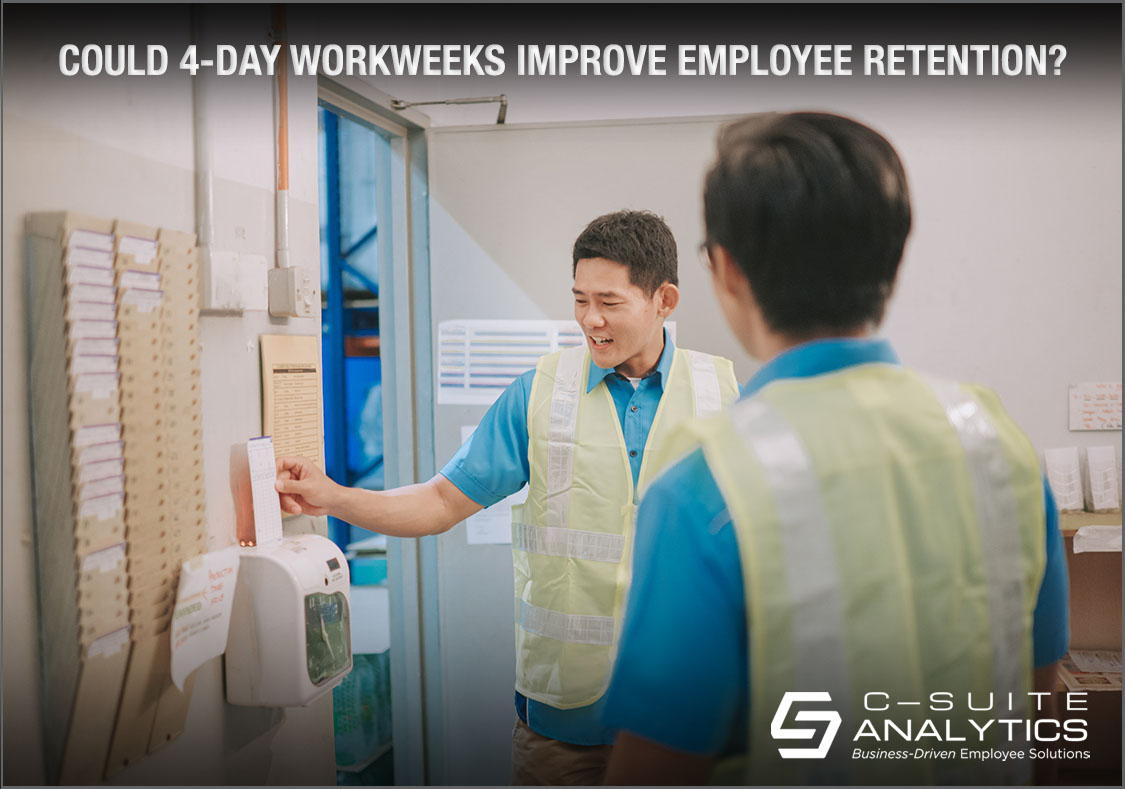Data shows a four-day workweek is popular with employees. On the company side, data suggests work satisfaction and productivity are up, recruiting is easier…and employee turnover is down. And during these days workforce shortages, every company is seeking a recruiting edge. Could this be “it”?
The Room-Silencing Question at SHRM Las Vegas

Let me first disclose the question and then the context:
Who here has ever heard of one manager getting fired for a low employee engagement survey score? Please raise your hand if you can think of even just one.
If there was a sound, it was the 400-or-so conference attendees turning their necks from front-to-back/side-to-side, to see if any lone wolves had raised their hands. There were no lone wolves.
The context was one we should all think about. As the grandparent of all employee engagement surveys, Gallup has continually told us that the number one driver of both employee engagement and employee retention is first-line supervisors. Adding more meat, Gallup also says just 14% of all employees who quit do so because of pay. Added to this is MIT’s research on the same topic which tells us that pay is the 16th– ranked reason that employees quit…implying there are a full 15 quit reasons that happen more frequently.
Gallup’s research presents the top reason employees quit as “employee engagement and culture”, whereas MIT’s work comes via their Revelio Institute which names the top quit reason as “toxic corporate culture”. Each provides three descriptors of their more broadly-stated reasons and each of the descriptors…a total of six…are behaviors delivered at the first-line leader levels.
—–
Further Reading: MIT says “Toxic Culture” driving “The Great Resignation”
—–
So the absolute power of first-line, direct supervisors on both engagement and retention is both dominant and clear.
Taking this data argument one giant step further, Gallup has been tracking employee engagement throughout the world since 2000. Their North America tracking includes both the U.S. and Canada, and here is the summary of their annual survey reports over this 24-year period:

Gallup is quick to point out that over this generation of time our levels of employee engagement have hardly changed. Which has to make us wonder how it can be that hundreds of thousands of companies conduct some form of employee engagement surveys each year but the greatest source of employee engagement data says there has been no improvement? That we are collectively wasting both our money and our time by implementing our resulting employee engagement solutions that are in reality not solutions at all?
These questions imply mystery but the answer is as clear as a bright-rising sun: that companies provide various one-size-fits-all programs to “fix” engagement while distancing themselves as far as they can from the true driver of engagement…good or bad…which again is each employee’s immediate, first-line supervisor.
As just one example, how do companies fix employee recognition? Employee-of-the-month, employee-of-the-year, employee appreciation week, get a backpack at five years and a clock at ten…all while what employees really crave is that their boss tell them they are doing a good job.
Given this context, it is no wonder that employee engagement never changes.
3 Questions About Your Engagement Survey’s Questions
- Are you providing survey data at the first-line leader levels or do you provide data at just the higher levels of your organization chart?
- How many of your survey questions ask your employees to specifically rate their supervisors on their performances about building trust, communicating, and providing feedback and recognition?
- If your survey does indeed provide you with first-line leader data, do you compare each supervisor’s performance survey-to-survey to learn if they are improving?
Most companies either don’t get first-line leader data or they pay no attention to it, and they particularly avoid watching for trendlines over several survey administrations. If they did watch those trendlines they would likely fire a few. But as the question posed last week at SHRM indicated, none of us in that room and likely no one who is reading this report can think of one supervisor who has been fired because he cannot engage with his team.
—–
Further Reading: Did Managers’ Engagement Drop? Gallup Says “Yes”
—–
This Leads to A Big Decision
So let’s apply some logic here. If the greatest driver of employee engagement is first-line supervisors but you choose to not survey at the first-line supervisor level, then stop conducting your employee engagement survey. Save your money, time, frustration, and hassle and do something better.
It Was During a Stay Interview Discussion
I asked the “any manager ever get fired” question during a discussion about Stay Interviews, and specifically about three bullet points that were on a slide. Here are the three:
- Bring information that can be used today
- Focus on individual employees including top performers
- Put supervisors in the solution seat
“Bring information that can be used today” points out the first contrast between Stay Interviews and engagement surveys, that Stay Interviews begin a natural series of ongoing, dynamic discussions about each individual employee’s levels of joy/satisfaction/frustration about her work for which individualized solutions can be developed…versus a once-per-year survey report that sits in our computers.
“Focus on individual employees including top performers” points out the simple difference between trying to improve work for an employee who you know versus for a group of employees who we see as a herd. An anonymous herd in fact. My mid-career work with an I/O psychologist taught me that top performers out-perform average performers by four-to-one, yet on any employee survey those top performers’ opinions are buried in an pile of others’ anonymous opinions.
“Put supervisors in the solution seat” matters most, indicating that first-line leaders must own their team’s engagement and also their retention…and that ownership includes being held accountable for improving both their employee engagement score and their employee retention from year to year.
So if you are struggling with improving employee engagement, structure your survey to include scores for your first-line leaders…and when a leader fails to improve a low score, call on your executives to terminate that leader. If they won’t, stop wasting your time conducting any engagement survey, forever.
Better yet, train your first-line leaders to conduct Stay Interviews as well as the managers above them, and to also build individualized stay plans for each employee as a result. The big win will be major improvements in employee engagement, employee retention, and most importantly greatly improved productivity. This is why you began doing your employee engagement survey in the first place.



